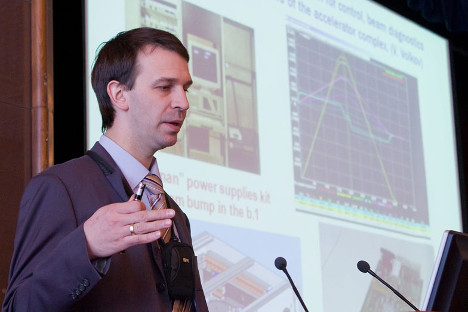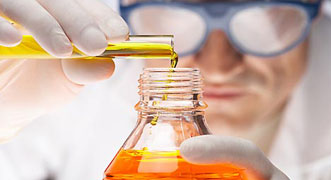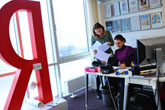Russian hadron collider prepares to unravel mysteries of the universe

Grigory Trubnikov: "Studying the state of quark-gluon matter will help find answers to how matter formed during the creation of the universe, and by which laws free quarks formed nucleons." Source: Dubna.ru
The Joint Institute for Nuclear Research (JINR), located in the city of Dubna outside of Moscow, is working on constructing the Nuclotron-based Ion Collider (NICA) facility.
With the help of this facility, Russian scientists plan to study the processes of nuclear matter formation that occurred at the early stages of the creation of the universe, and thereby unravel the secret of its birth.
Grigory Trubnikov, deputy chief engineer at JINR and a corresponding member of the Russian Academy of Sciences, talked about international cooperation on this project and research plans.
Russia Beyond the Headlines: The media refers to the NICA collider as the “younger brother” of the Large Hadron Collider (LHC). How exactly are they related? Do you cooperate with the European Organization for Nuclear Research (CERN)?
Grigory Trubnikov: We’re collaborating in several areas at once. First, Dubna helped develop several key technologies for the LHC, particularly particle beam diagnostics technology.
Essentially, the first beam circulations when the LHC was commissioned were diagnosed with the help of equipment delivered from JINC to CERN.
Dubna developed another unique device for the LHC – a system for suppressing transverse coherent beam oscillations. It took several years to develop it.
Several Russian enterprises, including military ones, took part in it, and now this system is running normally at the LHC in the entire range of its energy. Thanks to it, the beam’s parameters have remained stable over a long period of time, thereby ensuring that the collider works effectively.
In addition to that, graduates from our institute are now working at CERN and are responsible for several accelerators in the beam preparation chain.
RBTH: How is CERN participating in the NICA project?
G.T. CERN started showing interest in participation back before the NICA project was launched. We signed a general agreement with CERN in 2008 in which the organization expressed interest in helping build and operate the Russian collider.
We’ve been cooperating very closely for several years now, and we exchange technologies and developments. Their experts regularly visit us, our experts visit them, we participate in sessions on their machines, and they participate in ours. We have joint publications, joint test benches, and so on.
Besides that, CERN’s employees are members of our expert committee in both the accelerator and detector areas. They inspect the project’s key technological solutions twice a year. In addition, CERN shows us its developments in beam dynamic calculation software, as well as its administration program.
RBTH: Which of your other foreign colleagues are interested in participating in the project?
G.T.: We’ve signed general cooperation agreements with several organizations. Besides CERN, there’s the Brookhaven National Laboratory and the Enrico Fermi National Accelerator Laboratory (Fermilab) – two of the largest American accelerator centers. Besides them, there’s the German GMI Helmholtz Center for Heavy Ion Research – the largest research organization in Germany – and the FAIR project. The latter is oriented towards the same area of physics research as the NICA, so we are very reliable partners.
In August of this year, we held the first international forum on the participation of other countries in our project. Representatives of 11 countries came to Dubna, including Germany, Italy, South Africa, and India.
Six countries signed a protocol of readiness at the forum to become full participants in the project. Representatives of the Chinese Ministry of Science and Technology also took part, and we agreed to sign a similar agreement with them by the end of this year.
But now we’re cooperating with the Institute of Plasma Physics of the Chinese Academy of Sciences, which is developing and creating superconducting elements for NICA.
RBTH: What will be the main focus in the research at the Russian collider?
G.T.: We’ve identified two basic directions. The first, of course, deals with abstract science. That primarily entails research on the high density of nuclear matter.
Dense, hot nuclear matter is a relevant topic in global physics, especially in the last 10-12 years. It’s interesting because according to theoretical concepts, it’s precisely in this state that matter (free quarks and gluons, plus the protons and neutrons already formed from them) existed at the early stages of the formation of the universe.
Studying the state of quark-gluon matter will help find answers to how matter formed during the creation of the universe, and by which laws free quarks formed nucleons.
The second direction is applied research. We’ll put nuclear medicine at the forefront. By using our experience from working on superconducting accelerators, in the future we’ll be able to set up the production of compact accelerators for medical purposes, which will be used in particular for beam therapy for oncological diseases.
Right now there are about 15-20 such centers in the world, which help heal tens of thousands of patients a year. We expect Russia to catch up to its foreign colleagues in this area in the very near future, and we expect the accelerator technologies that we’re using in the NICA project to be applied in our nuclear medical centers.
In addition, we’re ready to test space equipment at the NICA collider complex’s accelerators – to study the effects of ionizing radiation on electronic devices and various electronic units of spacecraft. We’ll be able to model on land what will happen with these devices in space.
Another important applied area is information technology. We’ve already created and are developing a grid structure element to process data received during experiments at CERN at the LHC. It will soon be one of Russia’s largest distributed computing systems – a “virtual supercomputer” of sorts, which, of course, will be used for NICA, as well.
All rights reserved by Rossiyskaya Gazeta.
Subscribe
to our newsletter!
Get the week's best stories straight to your inbox



